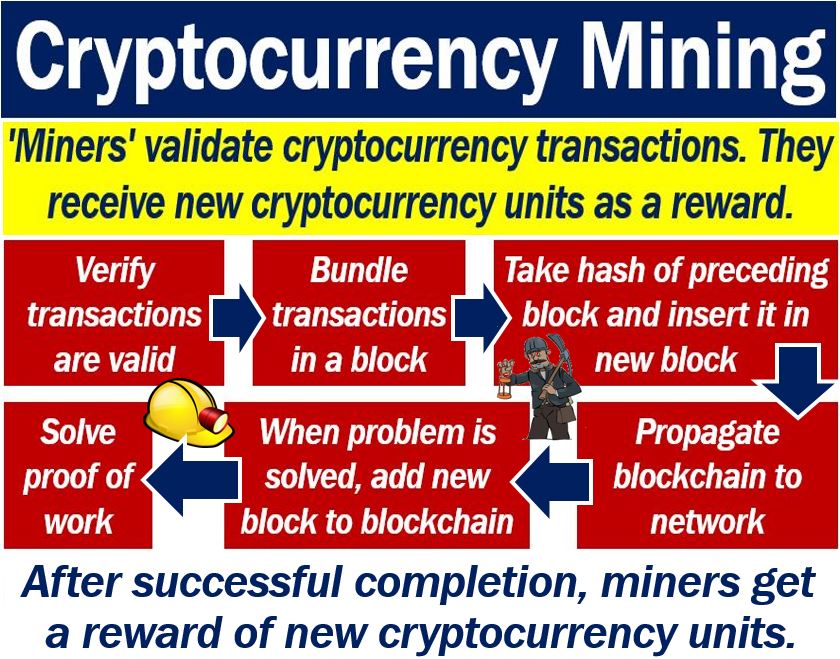Cryptocurrency Mining refers to the validation of transactions when using digital money, i.e., a cryptocurrency. We also call it Cryptomining.
Miners carry out cryptocurrency mining. Successful miners receive new digital money as a reward. The reward helps keep down transaction fees when people are using a cryptocurrency.
Moreover, the decentralized nature of cryptocurrency mining means that no single entity or government controls the issuance or distribution of the digital currency, distinguishing it from traditional fiat currencies.
Two functions
Cryptocurrency mining contains two different functions:
- First, adding transactions to the blockchain (verifying and securing).
- Second, releasing new currency.

Cryptocurrency mining – the blockchain
Since 2009, when cryptocurrencies came onto the market, many new terms have emerged. One of those terms is the ‘blockchain.’ We can also write it as two words, i.e., block chain.
To understand how cryptocurrency mining works, it is necessary to understand what the concept of the blockchain is.
We call the technology that underpins virtually all cryptocurrencies the blockchain. It is a ‘public ledger‘ or ‘decentralized record‘ of each transaction. Specifically, each transaction that people conduct using a cryptocurrency.
Miners collect data on each transaction and place the information in a ‘block.’ They subsequently authenticate each transaction.
For example, before the transaction has cleared, they check that nobody has spent the same coin again. They also check that the two amounts, i.e., input and output amounts, match.
The miners then link the subsequent block of transactions to the one they have just checked. By linking one block to the next, and then the next, etc., the miner creates chains of blocks. Hence the name ‘blockchain.’
The blockchain is the backbone of cryptocurrency transactions. It is also the basis for the generation of new cryptocurrency units.
Cryptocurrency mining – miners
Cryptocurrencies operate without a central bank, unlike traditional currencies such as the dollar, euro, pound, yen, yuan, or rupee.
As there is no central authority, somebody has to gather all the cryptocurrency transactions to form a new block.
We refer to the network computers that do this as nodes. After bundling a group of transactions into a block, they then add the block to the blockchain. Miners are people who work with the nodes to validate transactions.
The miner who assembled the block receives a reward. This reward is in the form of new digital money.
However, the creators of digital money have deliberately made the task of creating a block hard and lengthy.
They have done this because if it were easy, miners would create huge numbers of new currency units. The value of each cryptocurrency unit would subsequently devalue significantly.
The cryptocurrency mining process is complicated. Miners have to solve a complex mathematical problem. Each time they solve a problem they have completed a ‘proof of work.’
The first block ever to be mined was the Bitcoin Genesis Block. A Genesis Block is the first block of a blockchain.
Cryptocurrency mining – hashes
If a miner wants to create a block, they add a cryptographic hash to it. This hash must fulfill certain requirements.
The only practical way to match a hash is to do lots of calculations until the miner eventually gets a matching hash.
After finding the right hash, miners can then create a new block. Only then can they claim their reward of new units of cryptocurrency.
In an ITPRO article – ‘What is cryptocurrency mining?’ – the author explains that it is similar to a guessing game:
“Think of it like one of those competitions where you have to guess the weight of the cake – only you get unlimited guesses, and the first one to submit a correct answer wins.”
“Whoever can make guesses at the fastest rate has a higher chance of winning.”
Limits of cryptocurrency mining
Many miners are competing against each other trying to solve complex mathematical problems. Put simply; many are simultaneously calculating as many hashes as possible.
They want to be the first one to hit on the correct hash, i.e., the match. They then form a block and get their reward.
By deliberately making the hash calculations difficult, mining new blocks takes time. This deliberate slow speed ensures that the creation of new blocks is limited.
Therefore, the creation of new cryptocurrency units is also limited. That is how cryptocurrencies (hopefully) maintain their value.
What is a cryptocurrency?
A cryptocurrency is a type of digital money. In other words, it is money that only exists electronically.
It is an encrypted online currency. Cryptocurrency creators claim that encryption makes the money secure.
The most popular cryptocurrency is Bitcoin, which came out in 2009.
The second most popular cryptocurrency is Ether or Ethereum, which has been around since 2015.
Ethereum, distinct from Bitcoin, introduced the concept of ‘smart contracts,’ which are self-executing contracts with the terms of the agreement directly written into code, expanding the use cases of blockchain beyond simple transactions.
Bitcoin’s emergence marked the beginning of the decentralized financial movement, paving the way for the development of thousands of other cryptocurrencies and blockchain-based applications.
